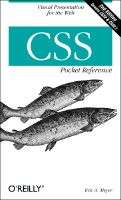Chris Adamson has an interesting post over at the O’Reilly Network about code in books and articles. In summation: should code be given a special license, separate from the actual text?
While CSS isn’t code, exactly, the same basic questions apply to the stuff I’ve written. Let’s take my most recent title, More Eric Meyer on CSS. It contains a copyright statement that says, in effect, you can’t reproduce the book’s text, in part or in whole, without permission. There is no distinction there between the explanatory text (“Margin collapsing is an interesting problem in some cases, and here’s why, blah blah blah…”) and the styles. Taken literally, the copyright statement says that you can’t re-use any of the CSS I created in your own designs.
This is clearly in opposition to what I think most of us would agree is the expectation, which is that you can use styles (or code) as you see fit but you can’t take the ‘narrative’ text and pass it off as your work. But where’s the dividing line? Suppose that, for whatever reason, you really like one of the designs in Project 4. We can agree that you should be able to re-use the styles presented, but a whole design? Is that fair? I can imagine many arguments both for and against, many of them variants on the classic slippery-slope argument.
In my particular case, the situation is even less clear. As anyone who drops by the book’s site will discover, the project files are freely available for anyone to download. You aren’t even expected to own the book as a condition of using them. That makes them less protected, I would think, than if they were on a CD that accompanied the book—but how much sense does that make? Again, I can envision several arguments on both sides of the issue. The same questions would arise for any author that provided code samples for download, as many do.
There’s also the question of what rights can or should be granted to the reader with regard to code. I might hypothetically make the styles all freely available to anyone, but only under the condition that attribution be given to the source (either me, the book, or both). Wouldn’t you, as a reader, find that rather annoying? I would. “You mean I have to give Eric credit just to use two CSS rules that create this cool effect?”
I’ve always operated on the principle that any markup or CSS I write about is fair game, because otherwise what would be the point of writing about how to use it? I can see it now: “use of the CSS presented in this tutorial, including any derivative works, without the written consent of the author is prohibited.” Yeah, right! That would be something like a dictionary prohibiting you from using any words you look up, including all modifications and misspellings.
So should books contain an explicit license regarding use of the code? If so, what kind? I expect readers and publishers will have different viewpoints, although the more clueful publishers probably won’t be too far away from the typical reader perspective. There’s a part of me that wonders why we even have to be explicit about this at all—after all, there’s been a sort of tacit acceptance of code re-use to date—but in a litigious DMCA world, this is an issue that probably has to be addressed sooner or later.
As I ponder the subject, I’m currently contemplating putting all my code samples under a Creative Commons ShareAlike 1.0 license, both now and into the future, just to make sure the bases are covered. Then again, perhaps an explicit Public Domain license would make more sense. Which one would be better, or is there a superior approach I haven’t considered? Let me know.

 I have in my hands a physical copy of the
I have in my hands a physical copy of the